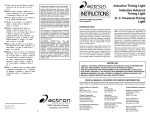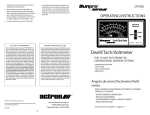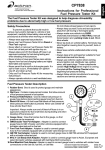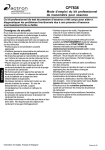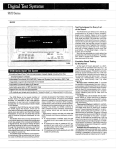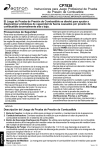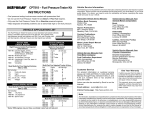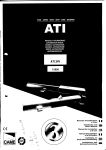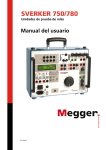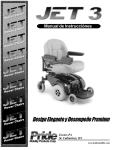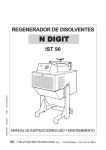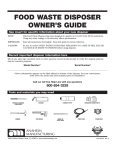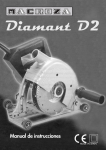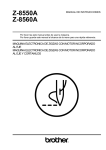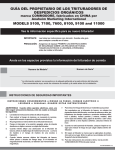Download Actron Inductive Timing Light User's Manual
Transcript
9. Llevar a cabo los pasos 1 a 8 para el sistema de avance centrífugo si es que todavía no se ha hecho. Inductive Timing Light Inductive Advance Timing Light D. C. Powered Timing Light GARANTIA COMPLETA DE UN (1) AÑO Actron Manufacturing Company, 15825 Industrial Parkway, Cleveland, Ohio 44135, garantiza al usuario que este equipo estará libre de defectos en los materiales y fabricación por un período de un (1) año a partir de la fecha de compra original. 10.Apagar el motor y conectar la bomba de vacío externa al diafragma de vacío en el distribuidor o a la computadora a bordo del vehículo. 11.Poner el control de avance de la luz de regulación en “0”. Volver a arrancar el motor. Cualquier equipo que llegue a fallar dentro de este período será reparado o reemplazado a entera discreción de ACTRON y sin cargo cuando sea devuelto a la fábrica. ACTRON solicita que junto con el equipo se envíe una copia de la boleta de venta original fechada, si el período de garantía todavía está en efecto. 12. Apuntar la luz de regulación a las marcas de regulación, pulsar el gatillo y observar la regulación del motor. 13.Ajustar la velocidad (rpm) del motor si es necesario, y aplicar los niveles de vacío al diafragma de vacío del avance, como se indica en el manual de servicio del vehículo. (Si es necesario reajustar las rpm del motor según las instrucciones del manual de servicio del motor, observar nuevamente la regulación del motor como se indica en el paso 12). Esta garantía no cubre los daños causados por accidente, modificaciones o el uso inapropiado o irrazonable. Los componentes de duración limitada, por ej., baterías, fusibles, bombillas de luces, tubos destellantes, quedan excluidos del amparo de esta garantía. ACTRONS PRODUCTS NO SE RESPONSABILIZA POR DAÑOS FORTUITOS O EMERGENTES DEBIDO AL INCUMPLIMIENTO DE CUALQUIER GARANTIA ESCRITA SOBRE ESTE EQUIPO. Algunos estados no aceptan el rechazo de responsabilidad por daños fortuitos o emergentes, por lo tanto esta negación de responsabilidad puede no servir en el caso suyo. Esta garantía otorga derechos legales específicos, y también pueden existir derechos que varía de un estado a otro. 14.Girar el control de avance de la luz de regulación hacia arriba hasta que la marca de regulación en el motor regrese a su punto de partida, como se observó en el paso 12. 15.Observar el avance de regulación (en grados) con cada aplicación de vacío y comparar el resultado con los valores dados en el manual de servicio. Si no se logra obtener las lecturas del avance de vacío podría significar fugas en el diafragma, mecanismo de avance pegajoso, o ausencia de vacío para accionar el diafragma del motor de vacío. INSTRUCTIONS INSTRUCCIONES EN ESPAÑOL Vea la pagína 9 INTRODUCTION Precise ignition timing is essential to achieve maximum fuel economy and performance out of any spark ignited engine. Your timing light provides a simple method for timing the engines used in today’s vehicles. The advance timing light provides the additional capability of allowing the user to check timing advance curves of the vacuum, mechanical or computer controlled types. lyzers which are capable of measuring engine RPM, and vacuum pumps for application of vacuum when required. Contact him for further information on these instruments. In the case of engines which are equipped with breaker point ignition systems, it will be necessary to check and, if necessary, adjust point dwell before adjusting timing. Make certain that the instrument that you have or intend to purchase has dwell measurement capability. Virtually all engines require that timing, both initial and advance calibrations be set, or checked at specific engine speeds, or in some cases with a specific vacuum applied to the vacuum advance diaphragm on the distributor, or on the vehicle’s on-board computer. Your supplier offers a number of engine ana- Metal cased timing lights are for use on twelve (12) volt negative (-) ground systems only. Plastic cased timing lights may be used on six (6) or twelve (12) volt, positive (+) or negative (-) ground systems by following the simple instructions in this manual. IMPORTANT CONSULT THE VEHICLE SERVICE MANUAL FOR SPECIFIC TUNE-UP INFORMATION AND TEST PROCEDURES. ALWAYS FOLLOW THE MANUFACTURER’S SPECIFICATIONS AND TEST PROCEDURES FOR ADJUSTING DWELL ANGLE AND IDLE SPEED, ESPECIALLY ON VEHICLES WITH MODERN ELECTRONIC IGNITION AND EMISSION CONTROLS. DO NOT ATTEMPT TO SERVICE A VEHICLE WITHOUT THE MANUFACTURER’S INSTRUCTIONS AND SPECIFICATIONS. 16.Después de completar todas las pruebas, asegurar de reajustar las velocidades en vacío y reconectar las mangueras o conectores eléctricos que fueron desconectados durante el procedimiento de prueba. VEHICLE MANUAL, SOURCES FOR SERVICE INFORMATION The following is a list of publishers who have service manuals for your specific vehicle at nominal cost. Write to them for availability and prices, specifying the make, style, and model year of your vehicle. ©1996 ACTRON MANUFACTURING CO. 15825 Industrial Parkway Cleveland, Ohio 44135 0002-000-219201 PRINTED IN U.S.A. 16 American Motors Corporation Myriad 8835 General Drive Plymouth Township, MI 48170 Buick Tuar Company Post Office Box 354 Flint, MI 48501 Chrysler Corporation Dyment Distribution Service Service Publication 20770 Westwood Drive Strongsville, OH 44136 Oldsmobile Lansing Lithographers Post Office Box 23188 Lansing, MI 48909 Ford Publications Department Helm Incorporated Post Office Box 07150 Detroit, MI 48207 Cadillac, Chevrolet, Pontiac Helm Incorporated Post Office Box 07130 Detroit, MI 48207 1 OTHER SOURCES- Nonfactory Domestic and Import Cars Chilton Book Company Chilton Way Radnor, PA 19089 Cordura Publications Mitchell Manuals, Inc. Post Office Box 26260 San Diego, CA. 92126 Motor’s Auto Repair Manual Hearst Company 250 W. 55th Street New York, NY 10019 SAFETY GUIDELINES TO PREVENT ACCIDENTS THAT COULD RESULT IN SERIOUS INJURY AND/OR DAMAGE TO YOUR VEHICLE OR TEST EQUIPMENT, CAREFULLY FOLLOW THESE SAFETY RULES AND TEST PROCEDURES SAFETY EQUIPMENT lease on the parking brake when the gear shift lever is removed from the PARK position. This feature must be disabled when it is necessary (for testing) to have the parking brake engaged when in the DRIVE position. Refer to your vehicle service manual for more information. Fire Extinguisher Never work on your car without having a suitable fire extinguisher handy. A 5-lb or larger CO 2 or dry chemical unit specified for gasoline/chemical/electrical fires is recommended. Fireproof Container Rags and flammable liquids should be stored only in fireproof, closed metal containers. A gasoline-soaked rag should be allowed to dry thoroughly outdoors before being discarded. Safety Goggles We recommend wearing safety goggles when working on your car, to protect your eyes from battery acid, gasoline, and dust and dirt flying off moving engine parts. HOT SURFACES Avoid contact with hot surfaces such as exhaust manifolds and pipes, mufflers (catalytic converters), radiator and hoses. Never remove the radiator cap while the engine is hot, as escaping coolant under pressure may seriously burn you. NOTE: Never look directly into the carburetor throat while the engine is cranking or running, as sudden backfire can cause burns. LOOSE CLOTHING AND LONG HAIR (MOVING PARTS) Be very careful not to get your hands, hair or clothes near any moving parts such as fan blades, belts and pulleys or throttle and transmission linkages. Never wear neckties or loose clothing when working on your car. JEWELRY Never wear wrist watches, rings or other jewelry when working on your car. You’ll avoid the possibility of catching on moving parts or causing an electrical short circuit which could shock or burn you. SIX (6) VOLT ELECTRICAL SYSTEMS BATTERY 2. Connect the BLACK clip from the timing light to the negative (-) terminal of the twelve (12) volt battery. SETTING THE BRAKE JACK Make sure that your car is in Park or Neutral, and that the parking brake is firmly set. The jack supplied with the vehicle should be used only for changing wheels. Never crawl under car or run engine while vehicle is on a jack. 2 All other instructions remain as listed. 1. Connect the RED clip from the timing light to the positive (+) terminal of the twelve (12) volt battery. The carbon monoxide in exhaust gas is highly toxic. To avoid asphyxiation, always operate vehicle in a well-ventilated area. If vehicle is in an enclosed area, exhaust should be routed directly to the outside via leakproof exhaust hose. NOTE The procedures outlined below instruct the user to connect the spark plug pickup (direct hookup or inductive clamp style) to the number one (1) spark plug wire. This procedure is valid for the majority of engines in use today. There are however, some engines which are timed using the “averaging” method. The most popular user of this method is General Motors where it is recommended for some of there smaller four (4) cylinder engines beginning in 1982. Your timing light has “average timing” capability. The only change in hookup is that instead of connecting the spark plug pickup to the number one (1) spark plug wire, it is connected to the coil tower wire, that is, the wire between the ignition coil and the center of the distributor cap. Consult your vehicle service manual for exact procedures. 5. Connect the RED clip to a secure engine ground such as the alternator/generator bracket or engine block. For safety reasons, do not use the positive (+) battery terminal or fuel system components as a ground connection point. Never smoke while working on your car. Gasoline vapor is highly flammable, and the gas formed in a charging battery is explosive. High voltage — 30,000 to 50,000 volts — is present in the ignition coil, distributor cap, ignition wires and spark plugs. When handling ignition wires while the engine is running, use insulated pliers to avoid a shock. While not lethal, a shock may cause you to jerk involuntarily and hurt yourself. NOTE: Some vehicles have an automatic re- 4. Connect the BLACK clip to the negative (-) battery terminal. SMOKING AND OPEN FLAMES HIGH VOLTAGE VENTILATION Steps 4 and 5 of LEAD CONNECTIONS below are revised to read as follows: Follow the steps listed below to use your timing light on vehicles equipped with six (6) volt electrical systems. A twelve (12) volt battery is required. This can be any automotive, or motorcycle battery. Do not lay tools or equipment on the battery. Accidentally grounding the “HOT” battery terminal can shock or burn you and damage wiring, the battery or your tools and testers. Be careful of contact with battery acid. It can burn holes in your clothing and burn your skin or eyes. When operating any test instrument from an auxiliary battery, connect a jumper wire between the negative terminal of the auxiliary battery and ground on the vehicle under test. When working in a garage or other enclosed area, auxiliary battery should be located at least 18 inches above the floor to minimize the possibility of igniting gasoline vapors missing, consult the vehicle service manual or appropriate service literature for the engine under test. It is important to note that preparation is specific to each engine. TWELVE (12) VOLT POSITIVE (+) GROUND ELECTRICAL SYSTEMS When using an advance timing light, note that average timing is used only for initial or base timing with the timing light’s advance control set fully counterclockwise at “0”. Timing advance measurements must be made with the inductive pickup clamped around the number one (1) spark plug wire. Timing advance measurements attempted with the inductive pickup clamped around the coil tower wire will not produce valid results. 3. Obtain a jumper wire (minimum wire size l8 AWG). 4. Connect one end of the jumper wire to the negative (-) terminal of the twelve (12) volt battery. 5. Connect the other end of the jumper wire to a clean, secure ground on the vehicle under test. The jumper wire must go to ground on the vehicle regardless of whether the vehicle is a positive (+) or negative (-) ground system. LEAD CONNECTIONS 1. Figure 1 shows the typical hookup procedure for most applications. To insure safety, follow the hookup sequence listed below. 2. Make sure the engine is OFF, and the ignition key is OFF. 6. Connection to the number one (1) spark plug and remaining procedures are the same as described later in this manual. 3. (Inductive Pickup equipped timing light) Clamp the inductive pickup around the number one (1) spark plug wire. Do not allow the inductive pickup to touch the exhaust manifold or surrounding parts as these areas become extremely hot and will damage the inductive clamp. ENGINE PREPARATION FOR TIMING In order for any engine to be base (initially) timed correctly, it is important to carefully follow the instructions as shown on the Vehicle Emission Control label. This label is located under the hood in the engine compartment. Some typical locations are: the underside of the hood, the fender well, a valve cover, or in the area of the hood latch. If the label is (Direct connection equipped timing light). Remove the number one (1) spark wire from either the spark plug end, or the distributor end, whichever is more convenient, but without compromising safety. See the NOTE below. 3 ENGINE TIMING CHECK Fig. 1 - Hookup Diagram Fig. 3 - (Breaker point equipped engines only) NOTE Positioning the Inductive Pickup for Reliable Readings The following timing adjustment procedure can be used on the majority of spark ignited engines in use today. Both General Motors and Ford Motor Company have introduced and used special versions of their common electronic ignition systems which sense ignition directly from the engine’s crankshaft via a crankshaft sensor. These systems were introduced in the late1970’s and were typically used only on a few of the “high line” luxury passenger cars. Timing is still checked with a timing light in the standard manner, however, timing adjustment is made at the crankshaft sensor, not by turning the distributor as is normally done. See your vehicle service manual for exact adjustment procedures on this type system. Check and, if necessary adjust dwell to specification before proceeding with timing check. 1. Prepare the engine for timing as indicated above in ENGINE PREPARATION FOR TIMING. 2. Clean, and chalk if necessary, both the rotating and stationary timing marks on the engine. See Figure 2. RED 3. Start the engine and allow it to warm to normal operating temperature (upper radiator hose is hot). BLACK 4. Check, and if necessary, adjust RPM to specified timing speed. 5. When using an advance timing light, make certain that the advance control is set fully counterclockwise at “0”. 6. Aim the timing light at the crankshaft damper (pulley) or transmission bell housing depending on the location of the timing marks on the engine under test. See Figures 1 and 2. 7. Pull the trigger switch on the timing light and observe the location of the rotating mark with respect to the stationary mark. If timing is within the tolerance as specified by the manufacturer (typically plus or minus 2 degrees) no adjustment is necessary and the procedure is finished. If it is not within specifications, proceed directly to the INITIAL TIMING ADJUSTMENT section below. If the timing light multiple flashes or flashes erratically on timing lights equipped with an inductive pickup, see NOTE below. NOTE On some engines, the distributor may be mounted very close to the carburetor, or fuel injection throttle body. Since this is an area in which there may be gasoline vapors present, it is adviseable on these engines to remove the number one (1) spark plug wire only at the spark plug end. Fig. 2 - DC A defective ignition system may cause the timing light to multiple flash or flash erratically. Low output spark voltage or a defective ignition wire may be responsible. You may be able to steady the flash by sliding the inductive pickup along the plug wire to a new location or reversing the inductive pickup as shown in Figure 3. (This may also help even with polarity sensitive pickups). Solid copper ignition wires radiate large amounts of radio frequency noise through the air which may interfere with the proper operation of the timing light and other electronic equipment. Replace solid copper ignition wire with resistance type wire if only for the tests described in this manual. Erratic flashing of the timing light can also be caused by dirt or grease buildup on the mating surfaces of the inductive clamp. To maintain proper operation of the clamp, clean and dry the inside clamp surfaces with a soft cloth when necessary as shown in Figure 4. 2. With the engine off, loosen the distributor hold down bolt just enough so that the distributor can be turned freely. Do not loosen the bolt beyond this point. See Figure 5. 3. Start the engine and allow it to warm to normal operating temperature (upper ra- Fig. 4 - Fig. 5 - 0 3 6 10 REMOVE AND PLUG VACUUM HOSE IF REQUIRED A 10 O 9. Re-connect any disconnected hoses or electrical connectors which were part of the engine's preparation for timing. Reset the engine’s idle speed if necessary. 1UDC 6 4. Connect the RED clip to the positive (+) battery terminal. TDC 4 OP 1-6 16N 5. Connect the BLACK clip to a secure engine ground such as the alternator bracket or engine block. For safety reasons, do not use the negative (-) battery terminal or fuel system components as a ground connection point. Cleaning the Inductive Pickup CLEAN AND DRY HERE 8. Shut off the engine. Disconnect the timing light leads in the reverse order from which they were connected. 10 Connect the spring adaptor and spark plug lead between the spark plug (or distributor cap) and the removed wire as shown in Figure 1. Route the timing light’s spark plug wire away from the exhaust manifold and surrounding hot areas to prevent damage. Various Timing Light Configurations NOTE Timing Adjustments l. Make certain that the engine has been prepared for timing as indicated above in ENGINE PREPARATION FOR TIMING. 5 Loosening the Hold-Down Clamp LOOSEN HOLD-DOWN BOLT Fig. 6 - TIMING ADVANCE Spark Advance Timing The following instructions apply only to advance timing lights. TIMING MARK The following advance system checks are general and may be used on most pre-emission controlled vehicles. Note however, that many vehicles have ignition and emission control systems, which may permit timing advance only under certain operating conditions. It is therefore important on these vehicles to check your vehicle service manual for specific instructions on how to perform advance system checks. ROTATION 4 2 0 2 4 Fig. 7 Fig. 8 Fig. 9 25 30 35 40 20 45 15 50 25 30 35 40 20 45 15 50 20 15 10 10 10 5 0 degrees advance STEPS 1 & 2 25 20 15 10 5 55 60 5 READING DAMPER WHEEL ONLY INITIAL ADVANCE IDLE RPM VACUUM HOSE DISCONNECTED 0 degrees 55 60 advance STEP 6 25 20 15 10 5 xya xya 0 READING ADVANCE TIMING LIGHT DIAL INITIAL ADVANCE IDLE RPM VACUUM HOSE DISCONNECTED 25 30 35 40 45 50 5 0 degrees advance STEP 7 STEP 8 25 20 15 10 5 READING CENTRIFUGAL ADVANCE AND INITIAL ADVANCE CENTRIFUGAL ADVANCE 2500 RPM VACUUM HOSE DISCONNECTED 0 0 5 55 60 5 5 CENTRIFUGAL ADVANCE SYSTEM Operational Test 1. Set the advance knob on the timing light to the “0” degree position shown in Figure 7. diator hose is hot). Adjust engine RPM to the value specified by the vehicle manufacturer for timing purposes. If no value is given, set the engine to curb idle. 2. With the distributor vacuum line disconnected and plugged (Figure 5) and the engine at curb idle, aim the timing light at the timing marks, press the switch to operate the timing light and note the position of the timing mark as shown in Figures 2 and 7. The timing mark or pointer should appear to be opposite one of the numbers (initial timing) as shown. 4. Aim the timing light at the timing marks on the engine and pull the trigger switch. 5. With the trigger switch pulled, and while observing the timing marks, rotate the distributor slowly clockwise or counterclockwise as necessary to bring the timing into factory specification. On most engines, a change in timing will change engine RPM. If this happens, reset the engine RPM as indicated in Step 3 above and repeat Steps 4 and 5 until timing and RPM are within factory specifications. 3. Gradually increase the engine speed to 2500 RPM while observing the timing mark position. 4. As the engine speed increases, the timing mark should appear to move smoothly in the opposite direction of engine rotation (the spark advance direction). See Figure 6. As engine speed is decreased, the timing mark should appear to move smoothly back to the initial timing mark noted in Step 2. 6. Shut off the engine. Tighten the distributor hold down bolt securely. 7. Start the engine and recheck the timing. If it drifted during the bolt tightening process, readjust it as necessary. 8. Shut off the engine. Disconnect the timing light leads in the reverse order from which they were connected. 9. Reconnect any disconnected vacuum hoses or electrical connectors which were disconnected as part of the engine’s preparation for timing. Reset the engine’s idle speed if necessary. on the timing light dial now indicates the total advance, that is, the initial advance plus the centrifugal advance in degrees (Figure 9). 6. Operate the engine at 2500 RPM or as specified by the vehicle manufacturer for the centrifugal advance check. The timing mark may appear to move off scale, and beyond the highest number. This may be normal for the RPM being used and particular vehicle under test. If initial timing specification is after TDC, this must be added to the timing light dial reading to obtain total advance. (You may also rotate the control knob further, to initial timing, thus eliminating the need for calculation. Total advance will then be shown). Check the result with manufacturer’s specifications. Repeat the test as required for various speeds as specified in the vehicle service manual. If the reading does not meet the manufacturer’s specification, it may indicate a problem with the centrifugal advance mechanism which should then be corrected by repair or replacement. 7. Direct the timing light at the timing mark and turn the control knob until the timing mark on the engine appears to return to the initial timing position (as noted in Step 2 above). The reading reached on the timing light dial now indicates the amount of centrifugal advance in crankshaft or engine degrees (Figure 9). Repeat the test as required for various speeds as specified in the vehicle service manual. NOTE NOTE Advance motion should be smooth. An uneven or erratic advance motion may indicate a defective centrifugal advance system which should then be serviced as necessary, according to the vehicle manufacturer’s instructions. Some manufacturers give advance specifications in distributor degrees and distributor RPM. Since the distributor rotates at one half of engine or crankshaft speed, the distributor specifications should be one half of what is indicated on the advance timing light dial. Vehicle test speed must also be doubled if test speed is listed for distributor RPM. It is therefore important to know if the vehicle service manual is presenting specifications in “engine” or “distributor” degrees and RPM. Calibration/Accuracy Test 5. Operate the engine at curb idle, direct the timing light at the timing mark and turn the control knob upscale until the timing mark on the engine appears to be at “0” degrees. (See Figure 8.) The number on the timing light dial indicates the initial advance in degrees, and should correspond to the 6 number obtained in Step 2. (This step does not apply to those engines whose initial timing is at or after Top Dead Center, TDC). VACUUM ADVANCE SYSTEM CHECKS Accurately checking the calibration of the vacuum advance system requires not only the advance timing light, but also a vacuum pump with gauge such as described in the INTRODUCTION at the beginning of this manual. Most vehicle service manuals will indicate specific advance in degrees for a given vacuum in inches of mercury. See your vehicle service manual for specific procedures. As with the centrifugal advance system checks, note whether specifications are in distributor or engine degrees. 9. Perform Steps 1-8 for the centrifugal advance system if not done as yet. l0. Stop the engine and connect your exter nal vacuum pump to the vacuum diaphragm on the distributor or the vehicle’s on-board computer. 8. Continue to turn the control knob until the timing mark appears at the “0” degree (TDC) mark on the engine. The reading reached 7 11. Set the timing light’s advance control to “0”. Restart the engine. Luz de regulación inductiva FULL ONE (1) YEAR WARRANTY Actron Manufacturing Company, 15825 Industrial Parkway, Cleveland, Ohio 44135, warrants to the user that this unit will be free from defects in materials and workmanship for a period of one (1) year from the date of original purchase. 12. Aim the timing light at the timing marks, pull the trigger and note engine timing. 13. Adjust engine RPM if necessary, and apply vacuum levels to the vacuum advance diaphragm as indicated by the vehicle service manual. (If it is necessary to reset engine RPM via service manual instruction, note engine timing again as indicated in Step12). Any unit that fails within this period will be repaired or replaced at Actron’s option and without charge when returned to the Factory. Actron requests that a copy of the original, dated sales receipt be returned with the unit to determine if the warranty period is still in effect. 14. Turn the timing light’s advance control up scale until the timing mark on the engine returns to its starting point as noted in Step 12. This warranty does not apply to damages caused by accident, alterations, or improper or unreasonable use. Expendable items, such as batteries, fuses, lamp bulbs, flash tubes are also excluded from this warranty. 15. Note the timing advance (in degrees) with each application of vacuum and compare the result with service manual values. Failure to obtain the vacuum advance readings may indicate a leaky diaphragm, sticky advance mechanism, or lack of vacuum to drive the vacuum motor diaphragm. ACTRON MANUFACTURING COMPANY DISCLAIMS ANY LIABILITY FOR INCIDENTAL OR CONSEQUENTIAL DAMAGES FOR BREACH OF ANY WRITTEN WARRANTY ON THE UNIT. Some states do not allow the disclaimer of liability for incidental or consequential damages, so the above disclaimer may or may not apply to you. This warranty gives specific legal rights, and you may also have rights which vary from state to state. 16. After all testing is complete, make sure to reset any idle speeds and reconnect any hoses or electrical connectors which may have been disconnected during the test procedure. INSTRUCCIONES Luz de regulación inductiva del avance Luz de regulación accionada por C.C. INTRODUCCION La regulación o reglaje preciso del encendido es esencial para lograr el máximo de economía y de combustible y rendimiento de cualquier motor de encendido por bujías. La luz de regulación proporciona un método sencillo para afinar los motores de los vehículos modernos. La luz de regulación del avance permite además probar las curvas de regulación del avance de los tipos controlados por vacío, mecánico o computadora. motores capaces de medir la velocidad (rpm) del motor, y bombas de vacío para aplicar vacío cuando se requiera. Para más información acerca de estos instrumentos, ponerse en comunicación con él. En el caso de motores equipados con sistemas de encendido de platinos, se deberá revisar y, si es necesario, ajustar el intervalo de reposo de los platinos antes de ajustar la regulación. Asegurar que el instrumento utilizado es capaz de medir el intervalo de reposo. Casi todos los motores requieren que la regulación, tanto las calibraciones iniciales y de avance, sea ajustada o probada a velocidades específicas del motor, o en algunos casos con un vacío específico aplicado al diafragma de avance al vacío en el distribuidor, o en la computadora a bordo del vehículo. El proveedor ofrece una diversidad de analizadores de Las luces de regulación en caja metálica se usan en los sistemas con negativo (-) a tierra de doce (12) voltios solamente. Las luces con caja de plástico pueden usarse en los sistemas con negativo (-) o positivo (+) a tierra de seis (6) o doce (12) voltios, siguiendo las instrucciones que se dan a continuación. IMPORTANTE CONSULTAR EL MANUAL DEL VEHICULO PARA LA INFORMACION ESPECIFICA ACERCA DEL AFINAMIENTO Y PROCEDIMIENTOS DE PRUEBA. SIEMPRE RESPETAR LAS ESPECIFICACIONES DEL FABRICANTE Y LOS PROCEDIMIENTOS DE PRUEBA PARA AJUSTAR EL ANGULO DE REPOSO Y LA VELOCIDAD EN VACIO, ESPECIALMENTE EN LOS VEHICULOS CON ENCENDIDO ELECTRONICO MODERNO Y CONTROL DE DESPRENDIMIENTO DE INDICACIONES Y ESPECIFICACIONES DEL FABRICANTE. MANUAL DEL VEHICULO, FUENTES DE INFORMACION ACERCA DE SERVICIO. La siguiente es una lista de editores que publican manuales de servicio para vehículos específicos a por un precio nominal. Escribirles para averiguar la disponibilidad y precios, especificando la marca, estilo y año del modelo del vehículo. 15825 Industrial Parkway Cleveland, Ohio 44135 8 American Motors Corporation Myriad 8835 General Drive Plymouth Township, MI 48170 Buick Tuar Company Post Office Box 354 Flint, MI 48501 Chrysler Corporation Dyment Distribution Service Service Publication 20770 Westwood Drive Strongsville, OH 44136 Oldsmobile Lansing Lithographers Post Office Box 23188 Lansing, MI 48909 Ford Publications Department Helm Incorporated Post Office Box 07150 Detroit, MI 48207 Cadillac, Chevrolet, Pontiac Helm Incorporated Post Office Box 07130 Detroit, MI 48207 9 OTRAS FUENTES-Privadas Automóviles americanos y extranjeros Chilton Book Company Chilton Way Radnor, PA 19089 Cordura Publications Mitchell Manuals, Inc. Post Office Box 26260 San Diego, CA. 92126 Motor’s Auto Repair Manual Hearst Company 250 W. 55th Street New York, NY 10019 REGLAS DE SEGURIDAD PARA IMPEDIR ACCIDENTES QUE PUEDAN CAUSAR GRAVES LESIONES Y/O DAÑAR EL VEHICULO O EL EQUIPO DE PRUEBA, SEGUIR ATENTAMENTE ESTAS REGLAS DE SEGURIDAD Y LOS PROCEDIMIENTOS DE PRUEBA. EQUIPO DE SEGURIDAD Extinguidor de incendios Nunca trabajar en un automóvil sin tener a mano un extinguidor de incendios. Se recomienda un aparato de CO2 ó agente químico seco de 5 lbs o más grande especificado para incendios de gasolina/químicos/ eléctricos. saca la palanca de cambio de la posición PARK. Se deberá inhabilitar esta características cuando sea necesario (para pruebas) con el fin de tener el freno de estacionamiento aplicado cuando la palanca esté en DRIVE. Para más información al respecto, consultar el manual de servicio del vehículo. SUPERFICIES CALIENTES Evitar el contacto con las superficies calientes como múltiples y tubo de escape, silenciadores (catalíticos), radiador y mangueras. Nunca quitar la tapa del radiador mientras el motor esté caliente, pues el escape de refrigerante a presión puede causar graves quemaduras. Envase ignífugo Los trapos y líquidos inflamables deben guardarse solamente en envases metálicos cerrados e ignífugos. Los trapos empapados en gasolina deben dejarse secar al aire libre antes de botarlos. Gafas protectoras Recomendamos usar gafas cuando se trabaje en el automóvil para protegerse los ojos contra el ácido de la batería, la gasolina y el polvo y suciedad desprendidos de las piezas en movimiento del motor. CIGARRILLOS Y LLAMAS EXPUESTAS Nunca fumar mientras se trabaje en el automóvil. El vapor de gasolina es muy inflamable, y el gas emitido por una batería en carga es explosivo. NOTA: Nunca mirar directamente al interior del cuello del carburador mientras el motor está girando o funcionando, pues el petardeo puede causar quemaduras. BATERIA No apoyar las herramientas o el equipo encima de la batería. La conexión a tierra imprevista del borne “HOT” (VIVO) de la batería puede electrocutar o quemar y dañar los cables, la batería o las herramientas y probadores. Tener cuidado de no tocar el ácido de la batería. Puede quemar y agujerear la ropa y quemar la piel o los ojos. ROPA SUELTA Y CABELLO LARGO (PIEZAS MOVILES) Tener cuidado de no tener las manos, cabello o ropa cerca de las piezas móviles como las aspas del ventilador, correas y poleas o varillaje del acelerador y transmisión. Nunca usar corbata o ropa suelta cuando se trabaje en el automóvil. Cuando se haga funcionar un instrumento de prueba desde una batería auxiliar, conectar un cable puente entre el borne negativo de la batería auxiliar y tierra en el vehículo que se esté probando. Cuando se esté trabajando en un garage u otro ugar bajo techo, situar la batería auxiliar a por lo menos 18 pulgadas del suelo para reducir al mínimo la posibilidad de inflamar los vapores de gasolina. JOYAS Nunca usar reloj pulsera, anillos u otras joyas cuando se trabaje en el automóvil. Se evitará la posibilidad de engancharse en las piezas móviles o causar un cortocircuito que podría electrocutar o quemar. VENTILACION El monóxido de carbono en los gases de escape es sumamente tóxico. Para evitar asfixia, siempre hacer funcionar el vehículo en un lugar bien ventilado. Si el vehículo está en un lugar encerrado, instalar una manguera a prueba de fugas en el tubo de escape para expulsar los gases al exterior. ALTO VOLTAJE Hay alto voltaje—30.000 a 50.000 voltios— en la bobina de encendido, tapa del distribuidor, cables del encendido y bujías. Para mover los cables del encendido mientras el motor está funcionando, hacerlo con alicates aislados para evitar electrochoque. Aunque no es mortal, un electrochoque puede causar una sacudida involuntaria y lastimadura. FRENO Asegurar que el vehículo esté en PARK o punto muerto y que el freno de estacionamiento esté aplicado. GATO El gato que se suministra con el vehículo debe usarse solamente para cambiar las ruedas. Nunca meterse debajo de un automóvil o motor funcionando mientras el vehículo esté apoyado en el gato. NOTA: Algunos vehículos tienen desconexión automática en el freno de estacionamiento cuando se 10 del capó. Si falta la etiqueta, consultar el manual de servicio del vehículo o instructivo apropiado correspondiente al motor que se está probando. Es importante notar que la preparación es específica para cada motor. SISTEMAS ELECTRICOS CON POSITIVO (+) A TIERRA DE DOCE (12) VOLTIOS Los pasos 4 y 5 siguientes de las conexiones de conductores han sido revisados como sigue: 4. Conectar la pinza NEGRA al borne negativo (-) de la batería. NOTA Los procedimientos descritos abajo indican al usuario que debe conectar la pinza de la bujía (conexión directa o tipo pinza inductiva) al cable de la bujía número uno (1). Este procedimiento es válido para la mayoría de los motores modernos. Sin embargo, existen algunos motores que se regulan usando el método del “término medio”. El usuario que más emplea este método es General Motors, que lo recomienda para algunos de sus motores más pequeños de cuatro (4) cilindros a partir de 1982. La luz de regulación tiene capacidad de “regulación promedial”. La única diferencia en la conexión es que en lugar de conectar la pinza de la bujía al cable de la bujía número uno (1), se conecta al cable de la torre de la bobina, es decir, al cable entre la bobina de encendido y el centro de la tapa del distribuidor. Consultar el manual de servicio del vehículo para los procedimientos exactos. 5. Conectar la pinza ROJA a una buena tierra en el motor, como el soporte del alternador/generador o bloque del motor. Por razones de seguridad, no usar el borne positivo (+) de la batería o componentes del sistema de combustible como un punto de conexión a tierra. Todas las demás instrucciones no han sido modificadas. SISTEMAS ELECTRICOS DE SEIS (6) VOLTIOS Seguir los pasos indicados a continuación para el uso de la luz de regulación con caja de plástico en vehículos equipados con sistemas eléctricos de seis (6) voltios. Se requiere una batería de doce (12) voltios. Puede ser cualquier batería de automóvil o motocicleta. 1. Conectar la pinza ROJA de la luz de regulación al borne positivo (+) de la batería de doce (12) voltios. 2. Conectar la pinza NEGRA de la luz de regulación al borne negativo (-) de la batería de doce (12) voltios. 3. Conseguirse un cable puente (calibre mínimo - 18 AWG). 4. Conectar una punta del cable puente a borne negativo (-) de la batería de doce (12) voltios. 5. Conectar la otra punta del cable puente a un puesta a tierra limpia y firme en el vehículo que se está probando. El cable puente debe quedar a tierra en el vehículo sin importar si éste tiene sistema eléctrico con negativo (-) o positivo (+) a tierra. 6. La conexión a la bujía número uno (1) y los procedimientos restantes son iguales a los descritos más adelante en este manual. Cuando se use una luz de regulación del avance, notar que la regulación promedial se usa solamente para la regulación inicial o básica con el control de avance de la luz de regulación puesto totalmente hacia la izquierda en “0”. Las mediciones de regulación del avance se deben hacer con la toma inductiva fijada alrededor del cable de la bujía número uno (1). Si se trata de tomar las mediciones con la pinza inductiva fijada alrededor del cable de la torre de la bobina, los resultados no serán válidos. CONEXIONES DE LOS CONDUCTORES 1. La figura 1 muestra el procedimiento típico de conexión para la mayoría de las aplicaciones. Para seguridad, seguir la secuencia de conexión dada a continuación. PREPARACION PARA LA REGULACION DEL MOTOR 2. Asegurar que el motor esté APAGADO y la llave de contacto en posición OFF (desconectada). Para que cualquier motor sea regulado inicialmente en la forma correcta, es importante seguir atentamente las instrucciones que aparecen en la etiqueta del control de desprendimiento de gases del vehículo. Esta etiqueta está pegada en la parte interior del capó en el compartimiento del motor. Algunos de los lugares típicos son: lado interior del capó, cavidad del guardabarros, tapa de válvula o en el lugar del pestillo 3. (Luz de regulación equipada con pinza inductiva) Fijar la pinza inductiva alrededor del cable de la bujía número uno (1). No dejar que la pinza inductiva toque el múltiple de escape o piezas circundantes, pues esos puntos se calientan mucho y dañarían la pinza inductiva. (Luz de regulación equipada con conexión directa) Desconectar el cable de la bujia numero uno (1) ya 11 Fig. 1 - PRUEBA DE LA REGULACIÓN DEL MOTOR Diagrama de conexión (Motores equipados con contactos del interruptor solamente) Fig. 3 - NOTA El procedimiento de ajuste de la regulación siguiente puede emplearse en la mayoría de los motores con encendido de bujías modernos. Tanto General Motors como Ford Motor Company han adoptado y usado versiones especiales de sus sistemas de encendido electrónico comunes, los cuales detectan el encendido directamente del cigüeñal del motor por medio de un sensor en el cigüeñal. Estos sistemas fueron usados por primera vez a fines de la década de los 70 y típicamente se usaban sólo en unos pocos automóviles de lujo. La regulación todavía se comprueba con una luz de regulación de la manera corriente, sin embargo, el ajuste de la regulación se hace en el sensor del cigüeñal, y no girando el distribuidor como se hace normalmente. Ver el manual de servicio del vehículo para el procedimiento de ajuste exacto en este tipo de sistema. Posición de la pinza inductiva para obtenerlecturasfiables Revisar, y de ser necesario, ajustar el intervalo de reposo según especificaciones antes de proceder con la prueba de la regulación. 1. Preparar el motor para la regulación, tal como se indica anteriormente en PREPARACION DEL MOTOR PARA LA REGULACION. ROJO 2. Limpiar, y marcar con tiza si es necesario, las marcas de regulación rotativa y estacionaria en el motor. Ver la figura 2. NEGRO 3. Arrancar el motor y dejar que se caliente a la temperatura normal de operación (manguera superior del radiador está caliente). 4. Comprobar, y si es necesario, ajustar las rpm a la velocidad de regulación especificada. 5. Cuando se use una luz de regulación del avance, asegurar que el control del avance esté totalmente hacia la izquierda en “0”. 6. Apuntar la luz de regulación a la polea del cigüeñal o caja de la transmisión dependiendo de la ubicación de las marcas de regulación en el motor que se está probando. Ver las figuras 1 y 2. 7. Tirar el gatillo en la luz de regulación y observar la ubicación de la marca rotativa con respecto a la marca fija. Si la regulación está dentro de los límites según lo especificado por el fabricante (típicamente ± 2 grados) no es necesario ningún ajuste y el procedimiento queda terminado. Si no está dentro de lo especificado, proceder directamente a la sección AJUSTE DE LA REGULACION INICIAL. Si la luz de regulación destella varias veces o lo hace erráticamente en las luces de regulación equipadas con una pinza inductiva, ver la NOTA a continuación. sea del extremo de la bujía, o extremo del distribuidor, el que más convenga, pero sin arriesgar la seguridad. Ver la NOTA abajo. NOTA En algunos motores, el distribuidor puede estar instalado muy cerca del carburador, o cuerpo del acelerador de inyección de combustible. Dado que esta es un área en la cual hay mucho vapor de gasolina presente, conviene en estos motores desconectar el cable de la bujía número uno (1) solamente en el extremo de la bujía. Fig. 2 - Diversasconfiguracionesde marcasderegulación 2. Con el motor apagado, aflojar el perno de sujeción del distribuidor lo suficiente para poder girar libremente el distribuidor. No aflojarlo más de eso. Ver la figura 5. 3. Arrancar el motor y dejar que se caliente hasta la temperatura de operación normal (la manguera DC 0 3 6 10 A 10 O LIMPIAR Y SECAR AQUÍ Fig. 5 - 1UDC TDC 12 OP 1-6 16N 5. Conectar la pinza NEGRA a una buena tierra en el motor, como soporte del alternador o bloque del motor. Por razones de seguridad, no usar el borne negativo (-) o componentes del sistema de combustible como punto de conexión a tierra. Aflojamientodelpernodesujeción DESCONECTAR Y TAPAR LA MANGUERA DEVACIO, SEGUNSE REQUIERA 9. Reconectar las mangueras o conectores eléctricos desconectados y que formaron parte de la preparación del motor para la regulación. Reajustar la velocidad en vacío del motor, si es necesario. 6 4. Conectar la pinza ROJA al borne positivo (+) de la batería. Limpieza de la pinza inductiva Fig. 4 - 8. Apagar el motor. Desconectar los conductores de la luz de regulación en orden inverso a la conexión. 10 Conectar el adaptador de resorte y conductor de la bujía entre la bujía (o tapa del distribuidor) y el cable sacado, como se muestra en la figura 1. Pasar el cable de la bujía de la luz de regulación lejos del múltiple de escape y puntos calientes circundantes, para que no se dañe. NOTA Un sistema de encendido defectuoso puede hacer que la luz de regulación destelle varias veces o erráticamente. La causa puede ser bajo voltaje de salida de la batería o un cable de encendido defectuoso. Se puede estabilizar el destello, deslizando la pinza inductiva a los largo del cable de la batería a un nuevo lugar o dando vuelta la pinza inductiva como se muestra en la figura 3. (Esto también a veces sirve para las pinzas sensibles a la polaridad). Los cables de encendido de cobre puro emiten gran cantidad de ruido de radiofrecuencia por el aire el cual puede estorbar el funcionamiento apropiado de la luz de regulación y otros equipos electrónicos. Cambiar el alambre de cobre puro por un alambre tipo resistencia, solamente para las pruebas descritas en este manual. El destello errático de la luz de regulación también puede ser causado por suciedad o acumulación de grasa en las superficies adosadas de la pinza inductiva. Para que la pinza funcione bien, limpiar y secar las superficies interiores de la pinza con un trapo suave, según sea necesario, como se muestra en la figura 4. Ajuste de la regulación 1. Asegurar que el motor haya sido preparado para la regulación como se indica en PREPARACION DEL MOTOR PARA LA REGULACION. 13 AFLOJAREL PERNODE SUJECION Fig. 6 - Regulacion del avance Regulación del avance de la chispa Las siguientes instrucciones son solamente para las luces de regulación del avance. MARCADE REGULACION Las siguientes pruebas del sistema de avance son generales y se pueden usar en la mayoría de los vehículos anteriores a los controles de desprendimiento de gases. Nótese, sin embargo, que muchos vehículos tienen sistemas de encendido y control de desprendimiento de gases que pueden permitir la regulación del avance solamente en ciertas condiciones de operación. Por lo tanto, es importante en que para esos vehículos se consulte el manual de servicio para las instrucciones específicas sobre la forma de realizar las revisiones del sistema de avance. ROTACION 4 2 0 2 4 xya xya SISTEMA DE AVANCE CENTRIFUGO superior del radiador está caliente). Ajustar la velocidad (rpm) del motor al valor especificado por su fabricante para la regulación. Si no se da ningún valor, ajustar el motor a velocidad en vacío reducida. Prueba operacional 1. Poner la perilla de avance de la luz de regulación en la posición de “0” grados, como se muestra en la figura 7. 2. Con la manguera de vacío del distribuidor desconectada y tapada (figura 5) y el motor a velocidad en vacío reducida, apuntar la luz a las marcas de regulación, pulsar el gatillo para hacer funcionar la luz y observar la posición de las marcas, como se muestra en las figuras 2 y 7. La marca de regulación o índice debe aparecer opuesta a uno de los números (regulación inicial) como se muestra. 4. Apuntar la luz de regulación a la marcas de regulación en el motor y pulsar el gatillo. 5. Con el gatillo activado, y mientras se observan las marcas de regulación, girar el distribuidor lentamente en sentido horario o contrahorario según sea necesario para dejar la regulación según las especificaciones de fábrica. En la mayoría de los motores, un cambio en la regulación cambiará la velocidad (rpm) del motor. En caso de que eso suceda, reajustar las rpm del motor según lo indicado en el paso 3 anterior y repetir los pasos 4 y 5 hasta que la regulación y RPM estén dentro de las especificaciones de fábrica. 3. Aumentar gradualmente la velocidad del motor a 2500 rpm mientras se observa la posición de la marca de regulación. 4. A medida que la velocidad del motor aumenta, la marca de regulación debe moverse suavemente en sentido contrario a la rotación del motor (dirección de “avance de la chispa”). Ver la figura 6. A medida que la velocidad del motor disminuye, la marca de regulación debe moverse suavemente de vuelta a la marca de regulación inicial, obtenida en el paso 2. 6. Apagar el motor. Apretar el perno de sujeción del distribuidor. 7. Arrancar el motor y volver a comprobar la regulación. Si varió durante el apriete del perno, reajustarla según sea necesario. 8. Apagar el motor. Desconectar los conductores de la luz de regulación en orden inverso al empleado en la conexión. NOTA El movimiento de avance debe ser suave. Un movimiento irregular o errático puede significar que el sistema de avance centrífugo está defectuoso y será necesario repararlo, de acuerdo a las instrucciones del fabricante del vehículo. 9. Reconectar las mangueras de vacío o conectores eléctricos que fueron desconectados como parte de la preparación del motor para la regulación. Reajustar la velocidad en vacío del motor, si es necesario. Prueba de calibración/exactitud 5. Hacer funcionar el motor a velocidad en vacío reducida, apuntar la luz de regulación a la marca de regulación y girar la perilla de control hacia 14 Fig. 7 Fig. 8 Fig. 9 25 30 35 40 20 45 15 50 25 30 35 40 20 45 15 50 20 15 10 10 10 5 0 degrees 55 60 advance PASOS 1 & 2 25 20 15 10 5 5 0 degrees PASO 6 25 20 15 10 5 50 5 0 degrees 55 60 advance advance LECTURADELA POLEASOLAMENTE AVANCE INICIAL RPM EN VACIO DESCONECTARLA MANGUERADE VACIO 0 5 55 60 25 30 35 40 45 LECTURA DEL DIAL DE LA LUZ DE REGULACIONDEL AVANCE AVANCE INICIAL RPM EN VACIO MANGUERADE VACIO DESCONECTADA PASO 7 PASO 8 25 20 15 10 5 0 0 LECTURADEL AVANCE CENTRIGUFOY AVANCE INICIAL AVANCE CENTRIFUGO 2500 RPM MANGUERADE VACIO DESCONECTADA 5 5 8. Continuar girando la perilla de control hasta que la marca de regulación aparezca en la marca de “0” grados (PMS) en el motor. La lectura obtenida en el dial de la luz de regulación ahora indica avance total, es decir, el avance inicial más el avance centrífugo en grados (figura 9). arriba hasta que la marca de regulación en el motor esté en “0” grados. (Ver la figura 8). El número en el dial de la luz de regulación indica el avance inicial en grados, y deberá corresponder con el número obtenido en el paso 2. (Este paso no se aplica a los motores cuya regulación inicial está en o después del punto muerto superior (PMS). Si la especificación de la regulación inicial es después del PMS, éste se de sumar a la lectura del dial de la luz de regulación para obtener el avance total. (También se puede girar un poco más la perilla de control, hasta la regulación inicial, eliminando así la necesidad de hacer el cálculo. Entonces se mostrará el avance total.) Verificar el resultado con las especificaciones del fabricante. Repetir la prueba según sea necesario para las distintas velocidades como se especifica en el manual de servicio del vehículo. Si la lectura no cumple con las especificaciones del fabricante, podría haber algún problema en el mecanismo del avance centrífugo, el que deberá corregirse ya sea por reparación o reemplazo. 6. Hacer funcionar el motor a 2500 rpm o según lo especificado por el fabricante del vehículo para la comprobación del avance centrífugo. La marca de regulación puede moverse fuera de la escala y más allá del número más alto. Esto es normal para la rpm en uso y el vehículo que se está probando. 7. Apuntar la luz de regulación a la marca de regulación y girar la perilla de control hasta que la marca en el motor empiece a regresar a la posición de regulación inicial (como se obtuvo en el paso 2 anterior). La lectura obtenida en el dial de la luz de regulación ahora indica la cantidad de avance centrífugo en grados del cigüeñal o motor. (Figura 9). Repetir la prueba según se requiera para las distintas velocidades como se especifica en el manual de servicio del vehículo. REVISIONES DEL SISTEMA DE AVANCE DE VACIO NOTA Algunos fabricantes dan especificaciones del avance en grados del distribuidor y rpm del distribuidor. Dado que el distribuidor gira a la mitad de la velocidad del motor o del cigüeñal, las especificaciones del distribuidor deberán ser la mitad de lo indicado en el dial de la luz de regulación del avance. La velocidad de prueba del vehículo también se debe duplicar si se lista la velocidad de prueba para rpm del distribuidor. Por lo tanto, es importante saber si el manual de servicio del vehículo se dan las especificaciones en rpm y grados del “motor” o del “distribuidor”. Para comprobar con exactitud la calibración del sistema de avance de vacío no solamente se requiere la luz de regulación del avance, sino también una bomba de vacío con manómetro como la descrita en la INTRODUCCION al comienzo de este manual. La mayoría de los manuales de servicio de vehículos indican el avance específico en grados para un vacío dado en pulgadas de mercurio. Consultar el manual de servicio del vehículo para los procedimientos específicos. Tal como sucede con las comprobaciones del sistema de avance centrífugo, observar si las especificaciones están en grados del distribuidor o del motor. 15
This document in other languages
- español: Actron Inductive Timing Light








